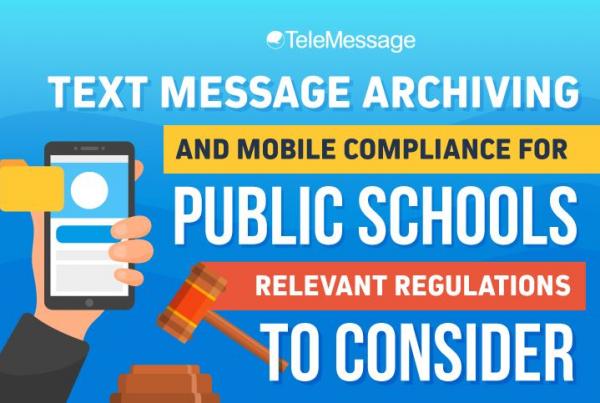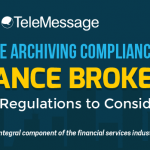The strategies and technologies that organizations can utilize to address text message archiving and mobile compliance have been well-discussed in countless articles and whitepapers on the internet.
In contrast, the ways to solve deployment implications of these technologies, as well the strategies to ensure that all BYOD mobile device users are using the permitted applications, instead of non-compliant apps such as iMessage in their business conversation, have not received the same level of attention.
Having full control of your business conversations starts by having the capability to enforce policies in your employees’ mobile devices – BYOD, CYOD, employer-issued, or any mix of all these. Searching for such solution in the market, though, further adds to the compliance challenge, as there are many jargons used in the enterprise mobility sector, which mainly includes MDM, EMM, MAM, and MIM.
In this post, we will simply explain what each of these technologies entail, how they are different from each other, and how they are crucial to your business SMS archiving and mobile compliance efforts.
EMM (Enterprise Mobility Management)
EMM is today’s all-inclusive software most vendors offer and includes MDM and MAM as their core features.
Previously, MDM was considered the umbrella term for all enterprise mobility solutions in the market. However, the Gartner research firm decided to change its annual Magic Quadrant report from MDM to Enterprise Mobility Management (EMM), effectively rendering MDM as just a component of EMM.
Recently, industry-leading EMM software in the market has started to incorporate advanced security features such as identity management (multi-factor authentication and federation), conditional access policies, as well as productivity apps such as note taking, file sync and share, corporate directory apps, and more.
MDM (Mobile Device Management)
MDM or Mobile Device Management is a software that allows IT administrators to control, secure, and enforce policies on smartphones, tablets, and other mobile devices used for business purposes.
Available as cloud service or on-premise software, MDM software uses a remote management protocol to execute actions like enforcing device passcodes and encryption, configuring email, Wi-Fi and VPN settings, locating, locking, or wiping lost or stolen devices.
MDM represents the foundation of today’s mobility management, according to most experts. It’s the EMM solution that is actually installed on the device and ensures that the device fits the business and compliance requirements of the organization.
However, since MDM software enforces policies and security on the entire device, most MDM providers in the market renamed their products ‘EMM’ to announce that they are not only capable of managing the device itself but also the software and information contained on the device as well.
MAM (Mobile Application Management)
WhileMobile Application Management used to compete with MDM, vendors ultimately realized that each product caters to completely different businesses mobility needs. As a component of an integrated EMM software, MAM enables organizations to have control over the enterprise apps installed on their employees’ devices.
Before it was integrated into EMM, MAM was a very popular tool for companies with increasing BYOD users in their workplace. Since MDM started to interfere with BYOD strategies of these companies, they use MAM to control and secure their own business applications on their employees’ personal devices without infringing on their employees’ privacy.
MAM solutions also often come with SDKs (software development kits), which allow organizations to develop custom enterprise apps with features their employees need. They can then make these custom apps available in an Enterprise App Store, which is a private catalog of corporate-sanctioned and secured mobile apps, such as secure messaging platforms and WhatsApp archiving app, that employees can install on their device.
MIM (Mobile Information Management)
Mobile Information Management is a software suite designed to keep sensitive business data encrypted on a mobile device and allow the organization to enforce a policy allowing only approved applications to access or transmit defined business data.
MIM software is often delivered on mobile devices through MDM or MAM, which makes it a good starting point for organizations that want to start their enterprise mobility efforts the right way. At least some components of these three options are required for successful mobility management, and in turn, can also lead for more efficient deployment of text message archiving tools, improved end-user behavior on company-sanctioned messaging apps, and more secure access and delivery of business data through various mobile channels.
TeleMessage offers mobile archiving solutions that can be fully integrated with the industry-leading MDM and EMM providers in the market – AirWatch and Ivanti.
By combining the enterprise mobile control with TeleMessage’s powerful Mobile Archiver products, organizations can retain mobile SMS, records voice calls, as well as WhatsApp chats, emails, and other mobile content, while enforcing MDM/EMM’s policy to give employees the freedom to communicate in real-time.
Deployment of TeleMessage’s Integrated MDM/EMM Solutions is simple and easy; With a click of a button you can push the TeleMessage App from your MDM/EMM Console. By utilizing the tight integration between TeleMessage and the leading MDM/EMM providers, you minimize your administration and management overhead, bringing users from your MDM/EMM console directly into TeleMessage’s Mobile Archiver app, maximizing the compliance and efficiency of your organization’s mobile fleet.
TeleMessage offers cross-carrier and international mobile text & calls archiving for corporate and BYOD phones. Contact us today to learn more about MDM/EMM Integrated Mobile Archiver products.





